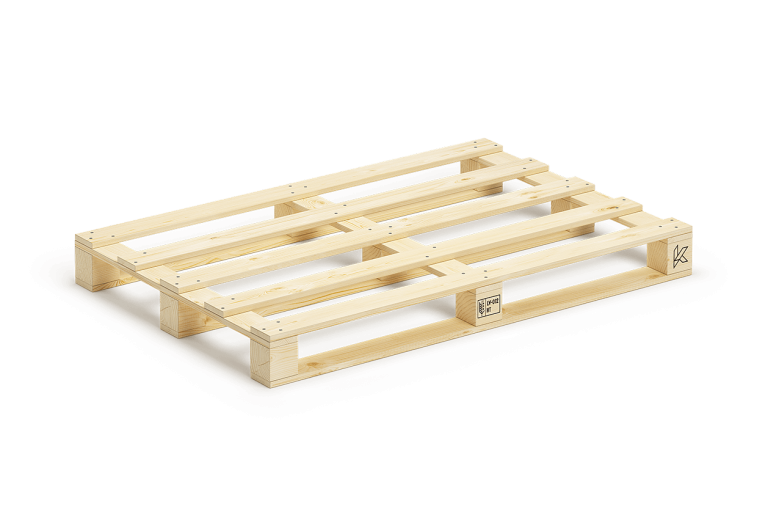€8.90
| Dimensions (W × L) mm |
Dimensions (W × L) in |
Wasted floor,ISO container | Region most used in |
|---|---|---|---|
| 1,016 × 1,219 | 40.00 × 48.00 | 3.7% (20 pallets in 40 ft ISO) | North America |
| 1,000 × 1,200 | 39.37 × 47.24 | 6.7% | Europe, Asia; similar to 40″ × 48″. Same footprint as a EUR 3 pallet. |
| 1,165 × 1,165 | 45.9 × 45.9 | 8.1% | Australia |
| 1,067 × 1,067 | 42.00 × 42.00 | 11.5% | North America, Europe, Asia |
| 1,100 × 1,100 | 43.30 × 43.30 | 14% | Asia |
| 800 × 1,200 | 31.50 × 47.24 | 15.2% | Europe; fits many doorways. Same footprint as a EUR 1 pallet. |
One way pallet, like other pallets, is used for the transportation of goods and storage in the warehouse. Theoretically, the pallet is intended for one-time use when shipping goods. The one way pallet is available in various shapes and sizes since it is not standardised.
Usually, the one pallet design is based on the customer needs and requirements or the type of goods that are being shipped. Contrary to the one way pallet, a reusable pallet is intended for multiple use when shipping goods.
The plastic pallet is made of HDPE. Featuring excellent mechanical performance, low weight and recyclability, Many businesses rely on this plastic pallet when transporting goods from the distribution warehouse to the sales floor. Their economic nestable space-saving feature ensures optimum efficiency when pallets stacks are empty which greatly reduces transportation costs making them ideal for both one-way trips and multi-use purposes. The sides provides easy access for forklift trucks and pallet jacks.
The standard 48×40 North American pallet, or GMA pallet, has stringers of 48 inches and deckboards of 40 inches, and was standardized by the Grocery Manufacturers Association (GMA).
- A standard wooden pallet (48 in × 40 in × 6 in or 1,219 mm × 1,016 mm × 152 mm) with a static load bearing capacity of 3 short tons (2.7 long tons; 2.7 t) and a 1-short-ton (0.89-long-ton; 0.91 t) dynamic capacity, will weigh approximately 33 to 48 lb (15 to 22 kg)
- GMA pallets typically weigh 37 pounds (17 kg), and are 6+1⁄2 inches (170 mm) tall. Their deck boards measure 3+1⁄4 inches (83 mm) wide and are 5⁄16 inch (7.9 mm) thick each. Other dimensions of pallets have different weight capacities.
Lightweight plastic pallets can weigh as little as 3 to 15 pounds (1.4 to 6.8 kg), while heavier models may weigh up to 300 pounds (140 kg). Standard GMA pallets can hold up to 460 pounds (210 kg).
Heavy duty International Plant Protection Convention (IPPC) Pallets are approximately 44 inches (1,118 mm) wide by 48 inches (1,219 mm) long, have three wood stringers that are a nominal 4 inches (102 mm) high by 3 inches (76 mm) wide timber, and weigh about 135 pounds (61 kg). Their deck is fully covered by 30 mm (1.18 in) plywood, and is painted in blue in European and Russian countries.
Two-way pallets are designed to be lifted by the deckboards.
Four-way pallets, or pallets for heavy loads (or general-purpose systems that might have heavy loads) are best lifted by their more rigid stringers. These pallets are usually heavier, bigger and more durable than two-way pallets.
ISO pallets
The International Organization for Standardization (ISO) sanctions six pallet dimensions, detailed in ISO Standard 6780:2003 Flat pallets for intercontinental materials handling — Principal dimensions and tolerances, which was reviewed and confirmed in 2014:
| Dimensions (W × L) mm |
Dimensions (W × L) in |
Wasted floor,ISO container | Region most used in |
|---|---|---|---|
| 1,016 × 1,219 | 40.00 × 48.00 | 3.7% (20 pallets in 40 ft ISO) | North America |
| 1,000 × 1,200 | 39.37 × 47.24 | 6.7% | Europe, Asia; similar to 40″ × 48″. Same footprint as a EUR 3 pallet. |
| 1,165 × 1,165 | 45.9 × 45.9 | 8.1% | Australia |
| 1,067 × 1,067 | 42.00 × 42.00 | 11.5% | North America, Europe, Asia |
| 1,100 × 1,100 | 43.30 × 43.30 | 14% | Asia |
| 800 × 1,200 | 31.50 × 47.24 | 15.2% | Europe; fits many doorways. Same footprint as a EUR 1 pallet. |











Reviews
There are no reviews yet.